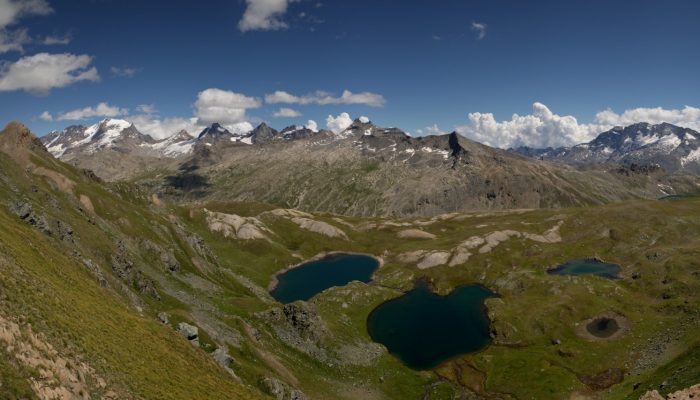
Among many other environmental impacts, human activities have introduced a range of animal and plant species to areas where they do not naturally belong. The introduction of alien species, as these translocated taxa are known, has wide ranging implications for native biota, ecosystem functioning, human health and the economy. Research published earlier this year found that during the last 200 years, the number of new established alien species has grown continuously worldwide, with 37% of all first introductions reported between 1970 and 2014. And their geographic reach is staggering too… you’ll even find them in the high peaks of the Italian Alps, as described in today’s post.
Above the tree line, small lakes punctuate the vegetated, rocky landscape of the Nivolet high plain in the Gran Paradiso National Park, Italy, at an altitude of about 2600 meters above sea level.
Geologically, this area is composed mainly of gneiss (a high-grade metamorphic rock), with relevant emergences of carbonatic rocks and extended cover of glacial deposits.
In several lakes, an alien fish (brook trout, Salvelinus fontinalis) was introduced in the sixties and seventies, drastically changing the lake ecosystems. A recent EU Life project on active ecosystem management succeeded in eradicating the alien fish in an ensemble of test lakes, restoring the original conditions. The Nivolet is now one of the pilot sites of the European H2020 Project ECOPOTENTIAL, devoted to assessing the state and changes of ecosystems and geosphere-biosphere interactions in Protected Areas by Remote Sensing, in-situ measurements and conceptual modelling. In particular, the Nivolet watershed has now been established as an Earth Critical Zone and Ecosystem Observatory.
By, Antonello Provenzale, researcher at the Institute of Geosciences and Earth Resources in Pisa, Italy, and collaborator of the Gran Paradiso National Park.
Imaggeo is the EGU’s online open access geosciences image repository. All geoscientists (and others) can submit their photographs and videos to this repository and, since it is open access, these images can be used for free by scientists for their presentations or publications, by educators and the general public, and some images can even be used freely for commercial purposes. Photographers also retain full rights of use, as Imaggeo images are licensed and distributed by the EGU under a Creative Commons licence. Submit your photos at http://imaggeo.egu.eu/upload/.
